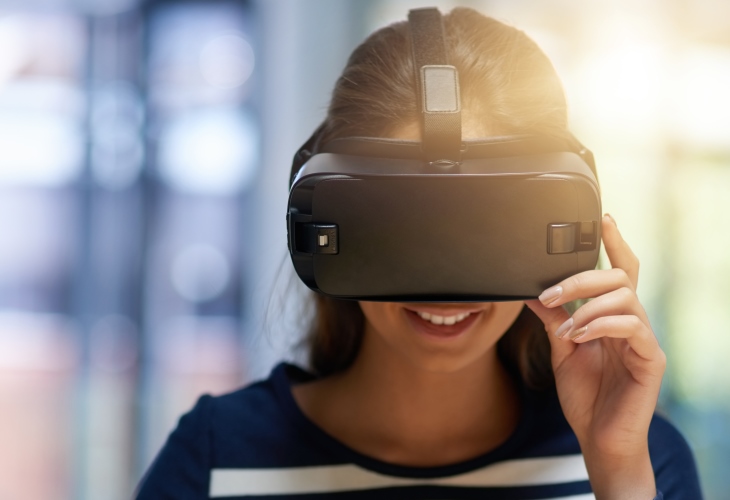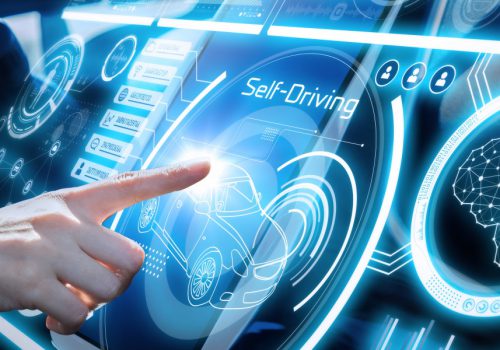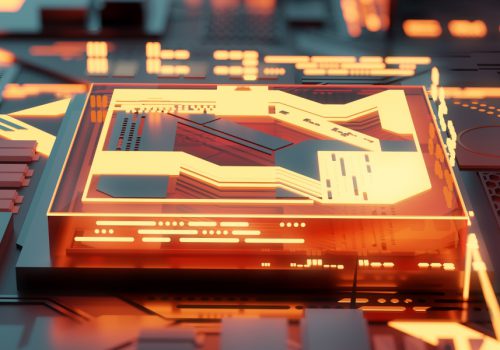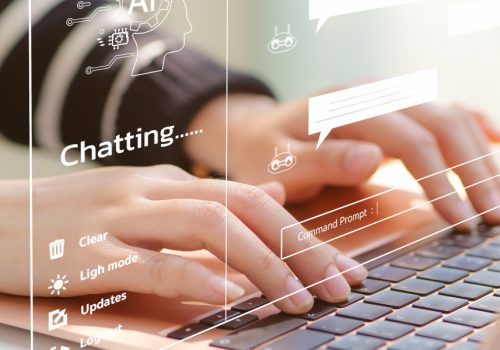Technology is ever-evolving and emerging with ground-breaking innovations in our daily lives. The world of technology continues to evolve at an unprecedented pace, shaping the way we live, work, and connect with one another. Currently, the world is dominated by virtual and augmented reality, Apple has consistently been at the forefront of technological innovation, transforming the way we live and bringing forth an immersive experience like never before. Recently, Apple Vision Pro marks a monumental leap in the realm of spatial computing. This headset seamlessly integrates into our daily lives, offering exciting features that enhance productivity and take you into a realm of technological wonder.
Where the Apple Vision Pro truly distinguishes itself are its exceptional features, pushing the boundaries of what we thought possible. Features such as video pass-through functionality are a marvel, offering unparalleled realism in virtual environments.
The Vision Pro introduces a new paradigm of spatial computing, enabling users to multitask in a threedimensional environment with unprecedented freedom. Users can open multiple apps simultaneously, arrange them in virtual spaces, and seamlessly transition between tasks with a simple glance and gesture. This spatial computing capability not only enhances productivity but also fosters creativity, empowering users to explore new ways of organizing and interacting with digital content.
Spatial Computing
a. A Paradigm Shift
Spatial context and movement within three-dimensional spaces are core human-sensory abilities, and thus, likely new growth areas in humanizing machine interactions. We can consider spatial computing the third wave of interactions in personal computing. Spatial computing, often described as the convergence of digital and physical worlds, is reshaping the way we interact with technology.
It is not just about touchscreens and voice commands; it is about integrating virtual elements seamlessly into our physical environment. Augmented reality (AR) and virtual reality (VR) are two key pillars of spatial computing, and Apple is determined to make them accessible to all through Vision Pro.
b. A Revolution in User Interaction
Spatial computing uses AI, computer vision, augmented and virtual reality, and other technologies to blend virtual experiences into a person’s experience of the physical world and create a form of computing that works in three dimensions.
The Apple Vision Pro rides the wave of spatial computing, an advanced technological paradigm that veers away from two-dimensional user interfaces. With the world’s first spatial operating system, visionOS, the Vision Pro breaks down the walls of conventional displays, crafting an expansive, three-dimensional workspace. This immersive UI responds intuitively to the user’s gaze, gestures, and voice commands, thereby, creating a near-physical experience of the digital space.

The Future of Spatial Computing
The Apple Vision Pro represents a significant step forward for the concept of spatial computing. As technology advances, the ability to merge the digital and physical worlds seamlessly becomes increasingly feasible. With its focus on spatial computing and augmented reality, Apple is positioning itself at the forefront of this emerging field.
Spatial computing has the potential to revolutionize various industries, from gaming and entertainment to communication and productivity. The Apple Vision Pro aims to be more than just a gaming device; it aspires to facilitate enhanced communication and interaction among family members and friends. By flipping through videos and photos in a more immersive and interactive manner, users can share their digital experiences in ways never seen before.
What Can You Do in Spatial Computing?
As spatial computing becomes more widespread, it can enhance our lives in a variety of ways, making our hobbies, passions, educational experiences, and jobs more immersive. Let us explore the range of possibilities:
a. Navigation
Spatial computing has the potential to transform how we navigate our world. Imagine never getting lost again, as your AR glasses guide you with turn-by-turn directions in the real world. Apple Maps could evolve to provide an entirely new level of navigation assistance, making travel more efficient and enjoyable.
b. Stargazing
Stargazing on the Apple Vision Pro may be the stellar app. With Apple’s high resolution plus true blacks, star gazing apps, or space apps in general, will be incredible experiences. In theory, you could perfectly represent the unpolluted night sky with lumen accuracy. For those of us in the city that would be amazing.
c. Virtual Home Design
Become a Designer Yourself, a planner 5D app for Apple Vision Pro combines 3D interior design and spatial experience, offering detailed customization and realistic views for both personal and professional use. VisionOS App allows you to modify interior designs in real-time by furnishing and decorating them virtually.
- View 3D design projects in stunning detail
- Play with and customize interior items and surfaces
- Explore renders and 360º panoramas in a fully immersive mode

d. Gaming
The gaming industry has already seen the potential of spatial computing with games such as Pokémon GO. With Vision Pro, Apple is taking this to the next level.
Imagine playing a video game that takes place in your living room, or watching a movie on a virtual big screen right in front of you. Apple Vision Pro promises to blur the lines between the real and the virtual, delivering gaming and entertainment experiences like never before.
e. Health and Fitness
The healthcare sector is embracing spatial computing to improve patient care. Surgeons can practice complex procedures in a virtual environment before performing them in reality. Patients can undergo therapy or rehabilitation in the comfort of their homes with the guidance of spatial computing applications. Apple Vision Pro is poised to revolutionize healthcare in myriad ways.
f. Virtual Shopping
The launch of Apple’s Vision Pro headsets in early February got many businesses thinking about how they can adapt to a future of “mixed reality”. Among early adopters in the retail sector, German luxury e-commerce firm Mytheresa has developed an app that enables customers to browse curated fashion collections in hyper-realistic animated environments such as Paris and Capri.
The business hopes to launch exclusive capsule collections in contextual environments on the visionOS app, while also featuring styling sessions with personal shoppers. Other retail pioneers of the tech include athleisure brand Alo Yoga, which has developed a wellness-first immersive experience that places customers in nature to enjoy meditation sessions before presenting them with new products, and furniture brand Wayfair, whose Decorify app enables users to reimagine their living spaces.
g. Spectator Sports
The Apple Vision Pro is poised to transform the sports fan experience with unprecedented access and personalization from the comfort of our homes. The NFL is second only to soccer globally; 115 million fans will tune in to watch the Super Bowl this year. Yet, only 70,000, or 0.06%, will participate in-person.
The Apple Vision Pro promises to bring the game to life, for those of us who cannot be there, in ways we have only dreamed of: from 360-degree immersion to real-time interactions with friends, fans, and commentators in the virtual stadium and personalized control over how we view and interact with the game.
h. Education
Spatial computing has immense potential in the field of education. From interactive history lessons to lifelike dissection simulations in biology, students can immerse themselves in the subject matter. Training in various industries, such as aviation or healthcare, can become more hands-on and immersive, thanks to AR and VR experiences facilitated by Vision Pro. In educational institutions and research laboratories, Apple Vision Pro will likely become an indispensable tool.
Its ability to analyze and process visual data in real-time enables educators and researchers to delve deeper into complex subjects. From interactive visualizations to datadriven insights, Apple Vision Pro enhances the learning experience and accelerates ground-breaking discoveries.
i. Industrial Factory Settings
Digitize physical space to analyze workers’ movement patterns, interactions with machines, and how long they spend on individual tasks. Then use this information to optimize their processes.
j. Health Care
The healthcare sector is embracing spatial computing to improve patient care. Surgeons can practice complex procedures in a virtual environment before performing them in reality. Patients can undergo therapy or rehabilitation in the comfort of their homes with the guidance of spatial computing applications.
Apple Vision Pro is poised to revolutionize healthcare in myriad ways.
k. Architecture and Design
Create immersive design models that allow clients and stakeholders to understand a proposed design better before making decisions.
l. Data Science
Collect data that has a geographical or spatial component and use approaches from data science, computer science, statistics, machine learning, automation, and artificial intelligence to solve complex spatial problems.

Redefining the B2B Landscape
Immersive Training: Helps the team to prepare to revolutionize how they learn. With interactive, handson virtual training sessions, staff can learn by doing, transforming training from a chore into an experience.
- Augmented Tech Support: Imagine enhancing troubleshooting and maintenance with AR-guided support, offering immediate, on-the-spot solutions and turning every challenge into an opportunity for growth.
- Interactive Product Demos: Elevate the sales process with immersive product demonstrations. Let clients explore features and functionalities like never before, making every demo not just informative but an experience in itself.
- Spatial Content Enhancement: Is reborn in a new dimension for watching existing content, appearing more engaging and realistic than ever before, capturing the imagination and attention of the audience like never before.
Challenges and Concerns
While the possibilities with Apple Vision Pro are undeniably exciting, it is important to address some challenges and concerns:
- Privacy and Security: As we integrate technology more closely into our daily lives, concerns about privacy and data security are paramount. Apple’s commitment to privacy should help alleviate some of these concerns, but they must continue to demonstrate their dedication in this area. Apple Vision Pro is built on a strong foundation of privacy and security and keeps users in control of their data. Optic ID is a new secure authentication system that analyzes a user’s iris under various invisible LED light exposures and then compares it to the enrolled Optic ID data that is protected by the Secure Enclave to instantly unlock Apple Vision Pro.
A user’s Optic ID data is fully encrypted, is not accessible to apps, and never leaves their device, meaning it is not stored on Apple servers. Where a user looks stays private while navigating Apple Vision Pro, and eye tracking information is not shared with Apple, third-party apps, or websites. Additionally, data from the camera and other sensors is processed at the system level, so individual apps do not need to see a user’s surroundings to enable spatial experiences. EyeSight also includes a visual indicator that makes it clear to others when a user is capturing a spatial photo or video. - Accessibility: Spatial computing has the potential to exclude those who are differently-abled. Apple must work on solutions that make Vision Pro and related experiences accessible to all.

Conclusion
Apple Vision Pro represents a significant step towards the future of spatial computing offering a glimpse into the future of immersive technology. It is not just a product; it is a testament to Apple’s commitment to innovation and improving our lives through technology. As we step into this new era of spatial computing, we can only imagine the limitless potential it holds for transforming every aspect of our world.
The power of spatial computing is unleashed, and Apple is leading the way. Whether it is for gaming, education, work, healthcare, or simply navigating the world, Apple Vision Pro is set to redefine how we interact with technology, making our digital experiences more integrated and more human-centric than ever before. The future is here, and it is through the lens of spatial computing that we will explore it.
On the other hand, there is some criticisms as well. According to The Verge, it is the defining trade-off of the Vision Pro.
The problem is the cameras are still cameras. And the displays are still displays. You can easily see motion blur when you move your head. Motion blur increases in low light. And it may lead to some weird wrapping of straight lines.









